Welcome back to Constellation Friday! Today, we will be dealing with one of the best-known constellations, that “watery” asterism and section of the sky known as Aquarius. Cue the soundtrack from Hair!
In the 2nd century CE, Greek-Egyptian astronomer Claudius Ptolemaeus (aka. Ptolemy) compiled a list of all the-then known constellations. This work (known as the Almagest) would remain the definitive guide to astronomy and astrology for over a thousand years. Among the 48 constellations listed in this book was Aquarius, a constellation of the zodiac that stretches from the celestial equator to the southern hemisphere.
Also known as the “Water Carrier”, Aquarius is bordered by Pegasus, Equuleus and Delphinus at the north, Aquila to the west, Capricornus to the south-west, Piscis Austrinus and Sculptor to the south, Cetus to the east and Pisces to the north-east. Today, it is one of the 88 constellations recognized by the International Astronomical Union (IAU), and is perhaps the most referenced and recognized of all the constellation.
Name and Meaning:
In Greek mythology, Aquarius was associated with the cup bearer of the gods – known to serve wine or water to Zeus. For his role, he was immortalized in the stars. In the ancient Greek version of the Deluge Myth, Aquarius was also identified as the one who unleashed the waters that flooded the Earth. As such, the constellation Eridanus was sometimes identified as being a river poured out by Aquarius.

It may also, together with the constellation Pegasus, be part of the origin of the myth of the Mares of Diomedes, which forms one of The Twelve Labors of Heracles. Its association with pouring out rivers, and the nearby constellation of Capricornus, may be the source of the myth of the Augean stable, which forms another of the labors.
Aquarius is one of the oldest recognized constellations along the zodiac, the sun’s apparent path through the sky. It is found in a region often called “The Sea” due to its profusion of watery constellations – such as Cetus, Pisces, Eridanus, etc. Sometimes, the river Eridanus is depicted as flowing forth from Aquarius’ watering pot.
History of Observation:
The first recorded mentions of Aquarius are found in the Babylonian star catalogs, where Aquarius is identified as “The Great One” and represents the god Ea himself (who is often depicted holding an overflowing vase). During this time, the Aquarius constellation contained the winter solstice. Hence why Ea was seen as the ruler of the southernmost quarter of the Sun’s path, and why the “Way of Ea” corresponded to the period of 45 days on either side of the winter solstice.
Aquarius also had negative connotations in Babylonian society, due to the fact that he was associated with the destructive floods that the inhabitants of the Euphrates and Tigris river basins regularly experienced. In Ancient Egypt, Aquarius was more positively associated with the annual flooding of the Nile. According to their mythology, the Egyptians believed that the riverbanks flooded when Aquarius put his jar into the river, which marked the beginning of spring.
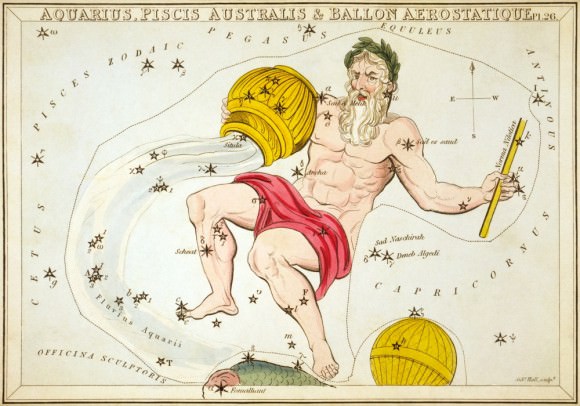
In ancient Greek mythology, Aquarius is sometimes associated with Deucalion, the son of Prometheus who built a ship with his wife Pyrrha to survive an imminent flood. Aquarius is also sometimes identified with Ganymede, the son of Trojan king Tros, who was taken to Mount Olympus by Zeus to act as cup-carrier to the gods. Neighboring Aquila represents the eagle who snatched Ganymede at Zeus’ behest (or as Zeus himself in animal form).
In Chinese astronomy, Aquarius is located within the northern quadrant of the sky, which is symbolized as the Black Tortoise of the North. The stream of water flowing from the Water Jar was depicted as the “Army of Yu-Lin”. “Yu-lin” translates literally to “feathers and forests”, which refers to the numerous foot soldiers from the northern reaches of the empire that were represented by these faint stars.
Other stars corresponded to “The Wall” (Leibizhen), “The Castle” (Tienliecheng) and Loui-pi-tchin (“The Ramparts”). The asterism that represents the “Water Jar” were also seen to the ancient Chinese as representing Fenmu (“tomb”), near to which the emperors’ mausoleum (Xiuliang) stood. In the 2nd century CE, Ptolemy included Aquarius in the Almagest, as one of the then-known 48 constellation. In 1922, the IAU included it in its official list of the recognized 88 constellations.
Notable Features:
Despite its prominent position in the zodiac, Aquarius doesn’t have any particularly bright stars. In fact, its four brightest stars are all less than magnitude 2. It’s second brightest, Alpha Aquarii (aka. Sadalmelik) is a yellow supergiant named in Arabic for the phrase “the lucky stars of the king”. This star has a magnitude of 2.94 (though it has an absolute magnitude of -4.5) and is located 523 light years from Earth.

The brightest star is Beta Aquarii (aka. Sadalsuud), a yellow supergiant that takes its name from the Arabic phrase that means “luckiest of the lucky stars.” This star is located 537 light years from Earth, and has an apparent magnitude of 2.89 and an absolute magnitude of -4.5. Gamma Aquarii (Sadachbia) is a blue-white giant located 163 light years from Earth and takes its name from the Arabic phrase sa’d al-akhbiya (“lucky stars of the tents”). There are also the blue-white giants Delta Aquarii (Scheat, or Skat) and Epislon Aquarii (Albali), and the white giant binary of Zeta Aquarii.
Aquarius is also home to several Deep Sky Objects. Because of its position away from the galactic plane, the majority of these take the form of galaxies, globular clusters, and planetary nebulae. These include Messier 2 (NGC 7089), one of the largest globular clusters in the Milky Way, located about 33,000 light years from Earth.
Messier 72 also calls Aquarius its home, a globular cluster located roughly 55,000 light years away. And so does Messier 73, an open cluster 2,500 light years from Earth. Two well-known planetary nebulae are also located in Aquarius, including NGC 7009 (also known as the Saturn Nebula) and the famous Helix Nebula (NGC 7293).
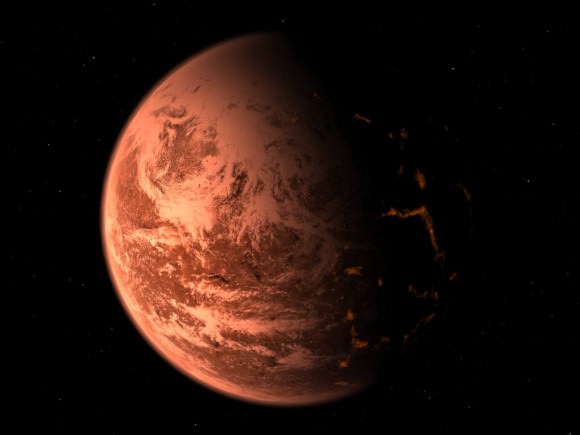
Recent research has shown that there are also twelve stars within the Aquarius constellation that possess planetary systems. These include Gliese 876, a red dwarf star system that is located 15 light-years from Earth, and which was the first red dwarf star to be found to possess a planetary system. It is orbited by four planets, including one terrestrial planet (Gliese 876 d) that is roughly 6.6 times the mass of Earth.
Gliese 849 is also located in Aquarius, a red dwarf star orbited by the first known long-period Jupiter-like planet (Gliese 849b). Then there’s the multiple-planet system of HD 215152, a white giant that is orbited by the planets HD 215152 b and c – both of which were discovered in 2011 using the radial velocity method. HD 215152 c is the larger one, at 0.0097 Jupiter masses, while b has approximately 0.0087 Jupiter masses.
Finding Aquarius:
Using binoculars or the naked eye, finding Aquarius can be done by first locating Alpha Piscis Austrini (aka. Formalhaut) in the night sky. From here, Aquarius’ brightest star (Beta Aquarii) can be found roughly 25° to the north-east. Alternately, look for Enif at the tip of the Pegasus constellation, and then move less than 10° south and a little to the east. Once found, this constellation offers many stargazing opportunities for amateur astronomers.
For those using binoculars and small telescopes, globular cluster M2 is a splendid object to look upon. While it is not quite so well-known, the four star asterism of M73 is also located in Aquarius and is an interesting sight with a small telescope. Small globular cluster, M72 also makes a very interesting small telescope target as well. For those who like binary stars, eta Aqr consists of a tight pair of F stars (F6IV and F3V) and both components are nearly of equal brightness showing 4.59 and 4.42 magnitude.
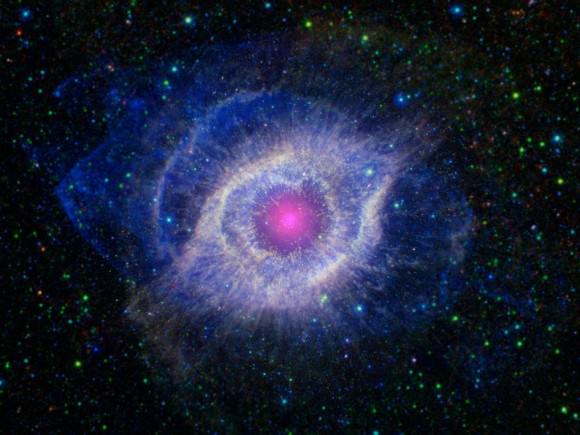
At a distance of just about 600 light ears the planetary nebula NGC 7293 – known as the Helix Nebula – is the closest of all planetaries and delivers an outstanding and interesting telescope view. Its apparent diameter is about the half of the Moon and is best viewed through binoculars or telescopes at minimal magnifications. It will appears to be a circular hazy patch, but to see it in its full beauty requires long-exposure photographs.
However, NGC 7009 belongs to the brightest planetary nebulae and shows bright and easily detail to the telescope. Because of its shapely resemblance to the planet Saturn it is called Saturn Nebula. In larger scopes, it appears as a bright inner ring surrounded by a patchy, blue colored disk. Small scopes show a misty greenish disk of 8th magnitude, but all show a delightful ansae which makes finding this planetary nebula worth the hunt.
There are five meteor showers associated with the constellation of Aquarius. The March Aquarids belong to the daylight showers which was first detected 1961 by C. S. Nilsson with radar methods. Activity can be detected from around March 11th to March 16 and may be associated with the Northern Iota Aquarid stream. The Southern Iota Aquarids begin around July 1st and end around September 18th. The peak date occurs on August 6th with an hourly rate of 7-8 meteors average.
The Northern Iota Aquarids occur between August 11th to September 10th. The maximum peak occurs on or about August 25th with an estimated fall rate average of 5-10 meteors per hour. Both streams produce meteors with an average magnitude slightly fainter than 3. The Delta Aquarids are two distinctly different streams. The Southern Delta Aquarids begin about July 14th and end around August 18th with a maximum hourly rate of 15-20 peaking on July 29th.
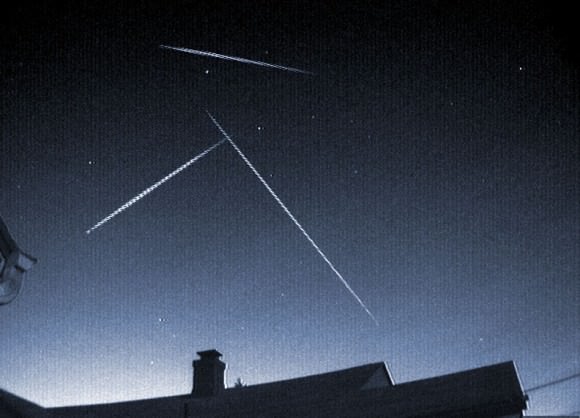
The Northern Delta Aquarids usually begin around July 16th and last through September 10th. The peak date occurs on or around August 13th with a maximum fall rate of about 10 meteors per hour. The Eta Aquarid meteor shower begins about April 21th and ends around May 12th. It reaches its maximum on or about May 5th with a peak fall rate of up to 20 per hour for observers in the northern hemisphere and perhaps 50 per hour for observers in the southern hemisphere.
Good luck with your stargazing, and don’t be afraid to cue up “Age of Aquarius” while you’re looking!
We have written many interesting articles about the constellation here at Universe Today. Here is What Are The Constellations?, What Is The Zodiac?, Zodiac Signs And Their Dates, and an article about the Eta Aquarid Meteor Shower.
Be sure to check out The Messier Catalog while you’re at it!
For more information, check out the IAUs list of Constellations. and the Students for the Exploration and Development of Space page on Aquarius and Constellation Families.

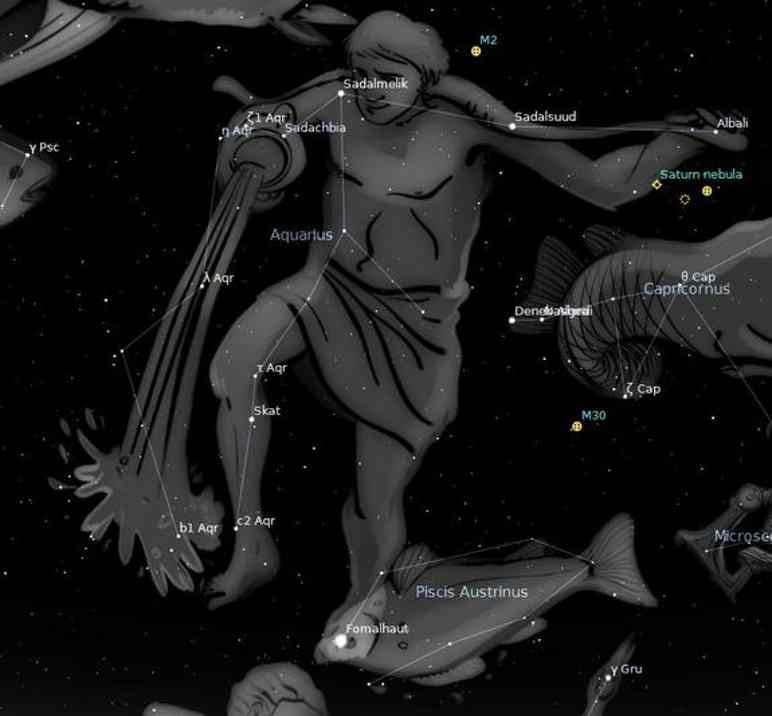
“Large but faint”, like the Great Bear, so one can’t see how it can also be the “most recognized”.
Not being able to address the author easily anymore is regrettable. I would’ve wanted to tell that in the few years that I spent in a penthouse with a balcony and access to the rooftop –the owner, an aunt, had died and we were waiting for a buyer to show up– I learned to look for the most recognizable constellations, and Aquarius was not among them. If I ever have the chance to go back to skywatching I wouldn’t know how to locate and sketch its shape. This was the case for all constellations with too many weak stars, like tiny Capricornius and huge Ursa Maior, the Great Bear. All one can see clearly of the latter is the Big Dipper, which is a small part of the grand whole (long tail that no bear ever had and hips).
The ones that stand out, from 4 degrees north of the terrestrial equator, are Orion, which looked like an hourglass with a little sugar cube in the middle, long twisting Scorpius, Libra, a small triangle that looks like an Asian peasant’s wide hat that Scorpius is wearing, the Sagittarius teapot, the isolated Cassiopeia double u, and the rhombus that is the Southern Cross and looks more like a small kite, but never the Centaur treading on it or maybe jumping over it.
Through a pirate-like hand held 30-power Tasco telescope the Pleiades look just like a Tiny Dipper, and that’s how they ought to be called.
The other attractions for someone with no fancy hardware are the full Moon, the shooting stars, the meteor showers, the artificial satellites, the high-flying air liners, the nearby lighted windows, the city lights and the UFOs, which never approached. The risk of being taken away and mistreated seems to be a modern old wives’ tale, so being there all by oneself is not something to avoid.